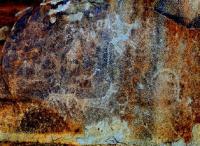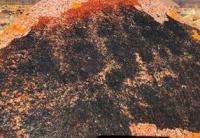Вы здесь
Petroglyphs in Chili-Sai Gorge.


Destinations and routes in Kyrgyzstan.
“He who conquers himself is the mightiest warrior”
Confucius.
The Great Silk Road Kyrgyzstan.
Petroglyphs in the Chili-Sai Gorge (Sahaba) the site is located 42km southwest of Osh, 8km west of Nookat, the district capital, 2km south of Sahaba mazar in the mouth of the gorge with the same name on the left bank of the Chiyli-sai River - Aravansay.
The shortest and most convenient way to Alai runs through the gorge. Geographic coordinates: NL 40 13 37.3, EL 43.4 72 31, altitude: 1,119m above sea level. Petroglyphs are carved at the bottom of the high vertical limestone cliff facing north.
They were repeatedly examined by archaeologists and regional ethnographers (Sher Ya.A., Devlet E.G., Amanbaeva B.E., Dzhusupakmatov L., etc.), but due to their inaccessibility, the petroglyphs were only surveyed in detail and documented in 2009 under the guidance of Amanbaeva B.E.
The main composition is at a height of over 2m above the valley and occupies an area 2.5x4 m. Some drawings were lost in the late 1980s to the construction of a modern road. The main panel begins at a height of 2 - 2.2m above ground and goes south-west.
The outermost drawing is at a height of 5.5m. A total of 62 drawings were registered. Pecking for all was medium and fine with a depth of 0.5-6mm to 2mm, the line width ranges from 6-7mm to 4.5cm. Repertoire. So-called “sun-headed” personages with hemispheric or spherical headed figures with schematic representation of trunks are of great interest.
Almost all types of drawings are outlined and a combined method of drawing was often utilized. No palimpsests or refreshments. The contours of most drawings are poorly visible, since the cliff surface is heavily eroded from the wind and patina either never existed or was lost.
Drawing heights range from 5.5cm to 56cm. The repertoire of the Sahaba petroglyphs includes only a few types: anthropomorphic “sun-headed” and mushroom-shaped personages, solar and some other vague signs. A drawing of a human in a composition with a mushroom-shaped anthropomorphic figure stands out.
Only two animal drawings are distinct – a mountain goat and the bull whose body is represented in a bitriangonal contour. The drawings of the “sun-headed” and signs persistently combine with several elements.
They can be divided into two groups: outlined or contoured circles on the trunks-legs with or without hands.
Contour shapes often have central dots and diverging line-rays. The hemispherical or circular shape of human images consists of two or four circles, separated by radial lines into equal segments with a dot in the center. Some figures are probably incomplete images of the “sunheaded” or mushroom-shaped characters.
The unique repertoire of Sahaba drawings distinguished the site among other petroglyph sites in Central Asia. Striking analogues of the Sahaba anthropomorphic figures are mushroom-shaped and some “sun-headed” images in the oldest group of Saymaly-Tash petroglyphs.
Together with Tamgaly in Kazakhstan, Sahaba is one of the main locations for “sun-headed” figures in Central Asia. Sahaba rock drawings are provisionally dated to the Bronze Age according to stylistic and iconographic analogies with the most ancient petroglyphs in Saymaly-Tash and Tamgaly.
Current Condition and Protection. The figures above the Sahaba anthropomorphs are associated with horse hooves and interpreted by locals as the hoof prints of Prophet Ali’s horse – Duldul – thus making them objects of worship.
In former years, a small pond formed at the foothill in spring and summer; at present, a wide ditch along the cliff prevents intrusive visitors from getting close to it. Not far from the petroglyphs, there is a Sahaba mazar (Arabic for “supporter”, in this case, of the Prophet Muhammad).
Popular tradition associates the formation of the shrine with the spread and establishment of Islam in this part of the Fergana Valley, which seems to reflect real events that took place here earlier in the Middle Ages.
The sacredness of this place goes back thousands of years as evidenced by the petroglyphs. However and most unfortunately, the cultic importance of the rock does not guarantee protection from acts of vandalism: many contemporary inscriptions were found on its surface.
The rock is not on the national list of sites. Boundaries of the site and zones of protection have not been established.
Authority:
«Rock Art in Kyrgyzstan». Bakyt Amanbaeva, Aiday Suleymanova, Chynarbek Zholdoshev.
Photos by
Alexander Petrov.







